Think about being involved in the design of a new network with critical applications, only to experience a loss of connection or a lag in connection speed, and no one knows why. These issues are often due to a mismatch or misconfiguration of fiber optic 1G SFP modules. Selecting the fiber optic transceiver is more than just ensuring successful data transfer; it is about establishing the reliability, scalability, and efficiency of your network.
When you understand specs, types of fibers, and where to deploy a fiber optic transceiver, you will achieve high-performing networks at a lower cost that will culminate far beyond the hardware investment.
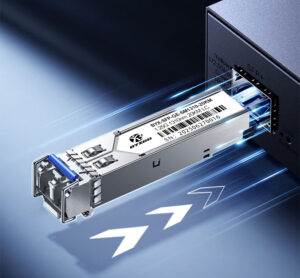
The Guide to 1G SFP Technical Specifications
At their core, 1G SFP modules are small optical or electrical transceivers that conform to 1000BASE Ethernet standards. Their function is to change electrical signals coming from switches or routers to optical signals, and vice versa, depending on whether they are being used with fiber or copper cables.
1000BASE-SX SFP transceivers are specifically designed to work with multi-mode fiber (MMF) and operate near the 850 nm wavelength. These transceivers are optimal for short to medium distances, which are generally less than 550 meters. These modules are also useful for intra-building links, such as connecting server racks on different floors, for example, in a data center.
In addition, MMF has a larger core size, allowing for better alignment of the optics when connecting the transceivers into the equipment, which makes the actual installation easier and cheaper. 1000BASE-LX SFP modules focus on single-mode fiber (SMF) and operate more toward the 1310 nm wavelength. These are designed for long-distance links, or roughly 10 km.
The length is a useful benefit for making campus-wide connections or connections in a metropolitan area. SMF has a much smaller core diameter, which allows the signals to travel farther because less dispersion of the signal occurs, but the alignment of the connectors is much more stringent than for MMF. These are good choices for bridging distant facilities or connecting buildings over a large campus.
For shorter runs inside a single office room or closely located racks, 1000BASE-T SFP modules will use standard copper Ethernet cables (Cat5e or Cat6). These modules will support up to 100 meters, with a good price point to connect devices without the need for fiber technology. These modules can give some control to the switching of legacy networks with copper interfaces and are electrically compatible with this technology.
When determining what effect to decide, you need to understand several key technical parameters of each SFP transceiver:
- Wavelength: This parameter defines the type of fiber compatibility as well as signal attenuation across the fiber. 850 nm is better suited for short runs in MMF; 1310 nm is better for long distances in SMF.
- Fiber Type: MMF is typically more cost-effective for short, powerful links; SMF is useful for long-distance links that are more resilient to interference. Copper is a standard option for electrical cabling as well.
- Maximum Distance: This will generally be determined based on both the fiber properties being used and the transmitter output power of the transceiver in question. This is important for understanding if repeaters or other intermediate devices would be needed to extend the connections.
- Power Budget: This covers the transmitter output power, the receiver sensitivity, and the margin the system would have in the application. The power budget is important for evaluating the data reliability in an application.
- Typical Use Cases: Data center scenarios will use short-reach SX SFPs; an enterprise level with campus buildings will most likely use LX; and a general office environment is the normal case for type to be the default.
Explore Our 1G SFP Product Line
The product catalog displays a wide selection of 1G SFP products available for various applications. Our offerings include dependable fiber optic SFP transceivers with compatibility for distance applications up to 10 kilometers. On the opposite end of the spectrum are our copper 1000BASE-T SFP modules, which are more suited for short distances. All products in the SFP module lineup meet strict quality control metrics.
In addition to quality, our entire lineup comes backed by reliability and interoperability, which ensure that our SFP modules can integrate seamlessly with all major network equipment manufacturers. Technical support is also available to discuss plans and result in an SFP module or type that will work for your device and network parameters.
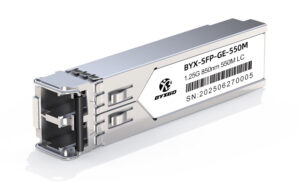
BYXGD-SFP-1.25G-MM-850nm-550M: This 1.25G multimode SFP transceiver is designed to operate at a wavelength of 850nm and is capable of stable data transmission of up to 550 meters. It is equipped with a VCSEL laser with an output power range of -9 to -3 dBm, receiver sensitivity ≤-24 dBm with a PIN photodiode, optical IC sharp extinction ratio of 9dB, and LC optical interface. This transceiver is excellent for short-haul, high-speed fiber connections and provides reliable performance in data center environments; particularly suited for organizations looking for cost-effective optical solutions. Custom configurations available.
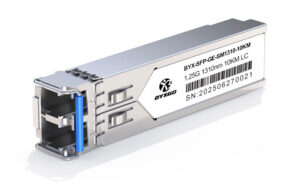
BYXGD-SFP-1.25G-SM-1310nm-10KM: The SFP module supports transmission with single-mode fibers over distances as far as 10 kilometers. It operates at a 1310nm wavelength and uses the Fabry-Pérot laser in the range of output power from -9 to -3 dBm. The receiver is a PIN photodiode that enables sensitivity of better than -18 dBm. With a constant extinction ratio, data is transmitted reliably. The SFP is equipped with an LC connector for easy connectivity in network equipment.
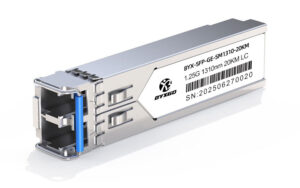
BYXGD-SFP-1.25G-SM-1310nm-20KM: The 1.25G single-mode transceiver operates at a 1310nm wavelength and supports distances up to 20 km. This transceiver has an FP laser with an output power ranging from -9 to -3 dBm and a PIN photodiode with sensitivity better than -22 dBm. It reliably transmits data at a 9 dB extinction ratio and has an LC connector for easy connection.
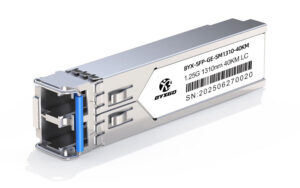
BYXGD-SFP-1.25G-SM-1310nm-40KM: This 1.25G single-mode transceiver operates at a 1310nm wavelength and supports distances up to 40 km. It uses a DFB laser with output power between -5 and 0 dBm, and a PIN photodiode with sensitivity better than -24 dBm. It features a 9 dB extinction ratio and supports reliable transmission. It also uses an LC connector for simple connection.
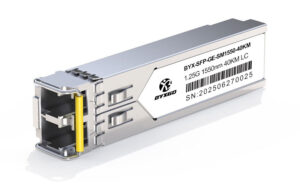
BYXGD-SFP-1.25G-SM-1550nm-40KM: This 1.25G SFP module operates with single-mode fiber at a wavelength of 1550 nm, and it can reliably transmit up to 40 km. It has a DFB laser that transmits -5 to 0 dBm, and a PIN photodiode receiver that has a sensitivity of -24 dBm or better. The module features a high extinction ratio for great clarity of signal as well as an LC connector that is compatible with easy incorporation into other network devices.
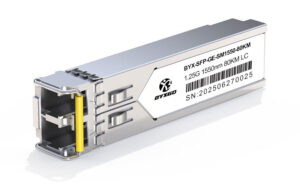
BYXGD-SFP-1.25G-SM-1550nm-80KM: This single-mode module operates at 1.25G over 80 km at the wavelength of 1550 nm. The transmitter is a DFB laser with output power from 0 to 5 dBm. The receiver consists of a PIN photodiode, which has a sensitivity of less than or equal to -24 dBm. The transmitter-receiver pair exhibits an extinction ratio of 9 dB, so the receiver would clearly detect the signal. An LC connector on the transceiver will allow for ease of use at the point of termination when the transceiver is incorporated into the services of a network device.
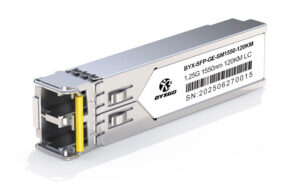
BYXGD-SFP-1.25G-SM-1550nm-120KM: The 1.25G single-mode module delivers transmission up to 120 km with 1550 nm. The module comes with a DFB laser output power of 1 to 5 dBm, while the APD receiver is highly sensitive with a sensitivity value of ≤ -31 dBm. The extinction ratio of the module is 9 dB. Furthermore, this module is equipped with an LC connector for easy integration with network devices.
The table below summarizes these metrics for the most common 1G SFP transceivers
| Module Type | Wavelength (nm) | Fiber Type | Max Distance | Use Case | Advantages | Limitations |
| 1000BASE-SX SFP | 850 | Multi-mode | Up to 550 m | Short intra-building links | Cost-effective, easy installation | Limited distance and reach |
| 1000BASE-LX SFP | 1310 | Single-mode | Up to 10 km | Campus, inter-building connections | Long-distance, low attenuation | Higher installation precision |
| 1000BASE-T SFP | N/A (Electrical) | Copper cabling | Up to 100 m | Desktop to rack, short office cabling | Cheap, compatible with Ethernet | Signal interference possible |
Models like sfp1g-sx-85 are useful where applications have short-distance, high-speed MMF connections. This type of SFP module provides the best combination of Tx/Rx power levels, cost, and performance in a local area application.
On the other hand, models such as sfp1g-lx-31 or 1000base-lx SFP transceiver units deliver the power and reliable connectors for long-haul connections across campus buildings or between campuses. In commercial or office applications using copper cabling, models like sfp-gb-ge-t or 1000base-t SFP are plug-and-play.
It is important to understand the transceiver power budget; for example, if the transmitter power levels are less than the minimum level, or if the receiver levels of sensitivity are not met, it can introduce error rates significantly. Understanding Tx/Rx levels, insertion loss, and any margin for each system is helpful when designing the fiber link and troubleshooting.
Connector type should be considered for the deployment; LC connectors are very common in fiber deployments due to their small form factor, while the RJ-45 connector remains the standard for copper. Considering all the technical details will help the deployment plan avoid costly rework in the future, help with signal integrity, and ultimately prolong the life of the link.
Choosing the Right 1G SFP: A Practical Decision-Making Framework
When selecting a 1G SFP module, you must first determine what distance you want to support your connection. Is the link under 550 meters, or a significant distance longer? If it is under 550 meters, multi-mode 1000BASE-SX modules will serve your needs reasonably well and at a lower price point. If the distance is greater than 550 meters, the single-mode 1000BASE-LX will provide much greater distance, along with reliability.
Next, the question arises: is your link fiber or copper-based? If 1000BASE-T copper-based modules fit your needs in the short-distance range and budget, this is most affordable but potentially limiting in a commercial or server environment. Fiber optic modules are impervious to, or vastly less sensitive to, electromagnetic interference, which is very important in a commercial or educational campus as well as industrial environments.
Next, cost versus performance is a consideration, which weighs in on more than just the price. In general, fiber optic modules will cost more initially than copper-based modules, but fiber will generally have a lower upkeep cost long-term, due simply to not deteriorating and increasing reliability over time. Copper will be less expensive in total initial purchase price but may cause issues with the link that will prove to be very costly (or even impossible) to fix.
Next, you must carefully consider the environment of installation. In industrial use cases, particularly where dust, vibration, or extreme temperature may be present, consideration of ruggedized or industrial fiber optic SFPs is needed. Likewise, if your use case is in a really dense network environment (e.g., data center), low-power, low-heat fiber optic SFPs are needed to keep overall energy consumption and consumption space as low as possible.
By this point, you have considered many important built-in factors for the SFP you will be selecting, but compatibility with your vendor and switch is important to avoid issues. A lot of network devices that use SFPs will only accept SFPs built by the same vendor, or they will require a certified or approved SFP. Either way, you do not want to buy the SFP and then have your network suffer operational disruption due to improper use or operational issues.
For some help in deciding, consider if you can answer the following questions:
- What is the maximum distance that the link is required to support?
- Is the environmental cable area electrically noisy, or is the cable used in a harsh area?
- When considering any budgetary constraints, does the budget allow for a total cost of ownership, or does it prioritize the initial price of SFPs?
- Do any network switches or routers that are used only accept certified SFP models?
- What are the throughput, latency, or reliability targets that need to be met?
Answering any of those questions will help with this SFP selection guide and ultimately help you decide the right 1G SFP module for your application and properly consider the appropriate technical specifications while appropriately applying your financial considerations.
1G SFP Troubleshooting & Maintenance: A Guide for Network Admins
Network administrators regularly struggle with familiar challenges with 1G SFP modules: link loss, intermittent link loss, or the modules not being detected by the switch at all. This is often where troubleshooting by going to the command line toolkit is useful, and referring to information provided by the command is important. For example, the show interfaces transceiver command captures issues at the module level (or use the device’s equivalent command).
The main data points include the transmit (Tx) optical power levels and the receive (Rx) optical power levels. If Tx optical levels drop below expected threshold levels or Rx optical values have too much attenuation, issues often arise, indicated by packet loss, link flaps, etc. It is important to measure these and other parameters to help isolate fiber or connector problems.
Digital Diagnostic Monitoring (DMI) provides internal flight details about the transceiver including temperature, voltage, and bias current. If the reading is outside of nominal, it can be determined that hardware may be aging, being exposed to improper temperature, or the wrong module was used, causing the module to intermittently fail.
Routine maintenance of the optical transceivers can eliminate performance degradation. Dust or oil on the end connectors that is often invisible can seriously attenuate the signal. Use clean, lint-free wipes and isopropyl alcohol to clean modules, and don’t forget the dust caps to cover the connections.
Treat the modules and connections with care to minimize the risk of electrostatic discharge or mechanical damage. Do not touch the bare ends of the connectors or allow the fiber ends of the transceivers to get too wet.
Control the environment. The racks in a data center are expected to be under controlled temperature and humidity conditions while the data center is operational. A dust-filtered HVAC system or air conditioning controls the fiber optic components and reduces agents of contamination that can degrade the performance of the SFP subcomponents.
A countdown checklist to work through:
- Confirm compatibility with the SFP modules are detected and firmware compatible.
- Check the Tx/Rx power with appropriate command line commands.
- Review DMI data to make sure the hardware is performing nominally.
- Clean and visually inspect the connectors and cables.
- Verify the environmental parameters meet the minimum manufacturer’s specifications.
Following these steps will make 1G SFP troubleshooting easier, ultimately prolonging the active life of fiber optic transceivers and avoiding unplanned outages.
